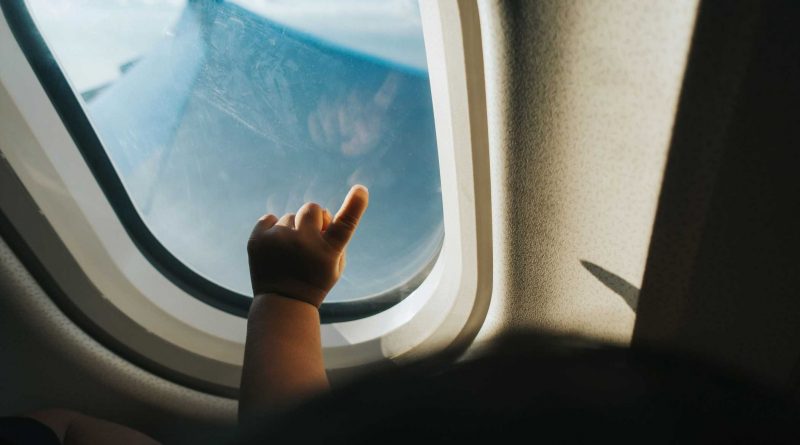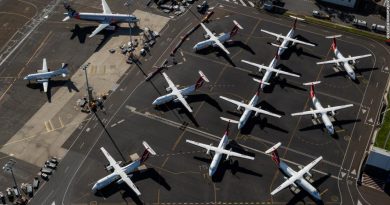Everything You Need to Know Before Flying With a Baby or Young Kids
Your baby’s first flight can be as momentous as their first steps, first solid food, or first drop off at daycare. And like all those milestones, parents can feel understandably freaked out beforehand. No one, not even your baby themself, knows how a child will react to being on an airplane for the first time. And no matter what happens, one thing’s for sure: you’ll be stuck in a cabin full of strangers for at least a couple hours while you find out.
But dread not—your child may love air travel, for starters—and even if they don’t, you will get through it. With a little planning, the right gear, and a willingness to make many lists, flying with a baby or young kids can be easier than you think. Here are our best tips for arriving in your destination with energy to spare, from seasoned parents.
All products featured on Condé Nast Traveler are independently selected by our editors. If you buy something through our retail links, we may earn an affiliate commission.
How to prepare
Right after you purchase your tickets, download Flying With Baby by Meg Collins, the blogger behind new mom survival guide Lucie’s List. Collins claims, accurately, to be the voice of reason about everything: “ticketing, check-in, car seats, feeding, napping and all the other stuff that makes your brain explode.”
There’s no surefire way to prepare a baby ahead of time, but if you’re traveling with a toddler or an elementary school-aged child, you may need to do a little incepting—i.e., plant the idea that flying is fun! and make a game of it at home beforehand. Traveler contributor Debbie Dubrow gave Traveler some excellent tips a few years ago that still hold true:
- Talk about your trip and your flight ahead of time, focusing on the aspects that are new to your child or might cause them concern.
- Read stories about flying, like Airplanes by Byron Barton for toddlers, and Richard Scarry’s A Day at the Airport for older kids. If you’re headed to a new destination, make a trip to the library to pick up a few books set in that place.
- Line up some dining chairs to make airplane seats, and act out how you should sit down and buckle up on a plane. Build a security checkpoint using a doorway as the metal detector and a cardboard box and towel as the conveyor belt and X-ray. Practice putting your child’s stuffed animal or blanket through the X-ray and getting it back on the other side.
- Let your children help pack their carry-on bags (but secret away a few new toys in your own). That way they’ll get to choose which items they just can’t live without, and you’ll get to set expectations about which toys are okay on the plane (leave the harmonica at home, please!).
What to pack
If this is your first time flying with a baby, you’ll be bringing significantly more items than you’ve flown with before. To keep track of everything, make an itemized list of the major items (i.e., the car seat, stroller); the bags you’re checking; and the bags you’re carrying on. Do a count of your bags like they’re children on a field trip when you get to the airport, get through security, and get off the plane. (If it sounds like overkill, think about what your trip might be like if you forget the one bag with your baby’s favorite stuffed toy. Yeah.)
As for what to bring? Everyone has their go-to items, but there are a few items we love most.
The Doona Infant Car Seat/Stroller (for infants up to 35 pounds) combines two of the most cumbersome items you have to bring on a trip. With the Doona you just gate check the stroller, and get to leave the car seat at home.
The Dohm sound machine helps little ones fall asleep and stay asleep in new and strange places. “I bring my son’s Dohm everywhere with us,” says director of strategic projects Lauren DeCarlo. “Hotels, my parents house. It’s essential.” You can also download white noise apps on your phone.
Several museums and tourist attractions don’t permit strollers. Having a baby carrier on hand is essential for those crowded, stroller-free environments—and if you’re traveling with a newborn, it’s sometimes just easier to let them sleep on your chest than worry about transferring them out of a stroller. The Líllé carrier transforms into six different positions that correspond to the baby’s age (it can hold up to an 18-month-old), and has an oversized pocket in the front so you can go hands-free and store the essentials, be it your cell phone or a pacifier.
Buy now: $120, lillebaby.com
Líllé Complete Baby Carrier
$120.00, Lille Baby
The Líllé Baby Carrier is a comfortable and functional carrier that adjusts into six different positions, so you can keep your (hopefully) sleeping baby against your chest during flight and prop them on your hip while you’re waiting to board.
A well-stocked diaper bag with enough wipes, diapers, and formula/breast milk/food to get you through the flight and an hours-long delay, minimum, is a must. Frequent flier, Skift aviation reporter, and father Brian Sumers recommends three days’ worth of food for the baby to account for any mishaps. Make sure you also have basics like hand-sanitizer, scented diaper trash bags, a pacifier clip (“this will save you the horror of watching a pacifier drop to the airplane floor,” says Traveler contributor and mom of three Juliana Shallcross), and one new baby toy. “I still swear by the one-new-toy trick,” Shallcross says. “Buy the baby one new toy specifically to open on the airplane. It will keep their attention for a little bit longer than if you brought an older toy. However, for young babies, you don’t need much. All they really need is their bottle, maybe a pacifier, and a nice seatmate who makes funny faces.”
The WayB Pico Car Seat is great pickup for kids that have outgrown the Doona. It weighs a barely noticeable eight pounds and folds up into a convenient carrying case. Note that this is a forward-facing car seat, so your child will have to be physically ready for that.
The Cares Airplane Safety Harness is the only FAA-approved harness for kids over the age of one, when they’re big enough for their own seat but too small for the seatbelt to do any good.
A different outfit—for you—is a gift. “A change of clothes is a no-brainer for the baby who may have a diaper situation at some point during the flight,” says Shallcross, “but if you can manage it, pack a T-shirt or leggings for yourself in your carry-on.” You don’t want to be stuck wearing a formula-stained shirt (or worse) for the rest of the flight.
As for what to leave at home? Anything you can get where you’re going: jars of baby food, diapers, wipes. Just make a beeline for a local grocery store once you arrive. It can also be fun seeing how other cultures and countries do the basics. (Fun fact: French diapers aren’t quite as absorbent as American ones. Who knew?)
Do babies need an I.D.?
Babies from the U.S. don’t need an ID when flying domestically, says the TSA. This is actually true of anyone under the age of 18. But they will need a passport to fly internationally.
To apply for a passport for your infant, both parents need to be there in person—“there” may be a USPS post office or a passport agency near you; if you’re the sole custodian of a child, you need to bring proof of that as well. You will also need the child’s birth certificate (original and a copy), your passports and U.S. drivers’ licenses (and a copy), a completed DS-11 form, money for the fees (credit is not accepted for the $80 standard fee and $35 acceptance fee—bring cash or your checkbook), and—the best part—two identical 2×2 inch passport photos of your baby. There are websites dedicated to getting your infant to sit upright and still against a plain white backdrop for long enough to get a photo. Some, like epassport.com, will prepare your photos with a guarantee that your baby’s photo won’t be rejected (check your passport application location’s policy on this, as some don’t allow third parties to send in photos).
Here’s the full list of what you need to get the baby’s passport.
What about their own ticket?
It depends. On most airlines, babies under the age of two can sit in your lap on a flight, sometimes with a special lap belt that you attach to your seatbelt. You may have to pay a fee—primarily on international airlines—which may come with a special boarding pass. It helps to call the airline before booking to confirm. Once the child turns two, they are required to have their own ticket.
Still, if you can swing it, we suggest purchasing your baby their own seat from the get-go. It will be more pleasant to have the extra space (and a buffer from other passengers) and, as Sumers says, it’s safer: “You wouldn’t hold your baby in your lap in a car, even if you were only going a mile away at 10 mph. So why would you hold your baby on an airplane racing on a runway at 150 mph? In severe turbulence, or in a survivable crash, you may not be not able to hold onto your baby.”
At the airport
When flying with kids, arrive early to the airport, so you have extra time to check in, get through security, and board the plane.
Going through security
If you have TSA PreCheck, children 12 and under can get in line with you and breeze on through. But if you have Global Entry, the baby needs it, too. Here’s what it takes to apply.
When it comes to getting your stuff through, TSA checkpoints are “wildly inconsistent” across different airports in the U.S., says Shallcross. “If you’re traveling with breast milk or formula, note that you can carry-on [in excess of the 3.4 oz liquid rule], but you will most likely be on the receiving end of a pat-down.” Having TSA PreCheck makes the process go a bit faster, and sometimes, in lieu of a screening, TSA will test to-go bottles of formula instead. International checkpoints also vary widely, but, often, jars of food and bottles get checked.
As for the stroller you plan to gate check, know that it will have to go on the belt through the x-ray machine, like the rest of your bags. It may be pulled aside and tested or swabbed by a TSA agent.
Getting to the gate
Speaking of gate-checking: “As soon as you make it through security, head to your gate and get the gate tags for your stroller,” says Shallcross. “If you wait until you board, the gate attendants may ask you to step aside and wait until they finish boarding the group, before they give you the tags.”
And then there’s the age-old question: Should you board in the first wave with your baby and toddlers? Most gate agents give you the option of early boarding—and with a newborn or infant, that’s the way to go so you can get settled with bags stowed and essentials out for takeoff. But with an active toddler? That means you’re on the plane for an extra 30 to 45 minutes, trying to contain their wild energy in a small space. No thanks.
If you’re traveling with another adult, super traveler Sam Brown recommends dividing and conquering. One of you boards early with the bags; the other stays behind with the kids, letting them burn off energy at the gate until the last possible minute you can board.
Nursing and pumping
If you need a quiet space to breastfeed before boarding, look for a Mamava Pod. They’re designed to allow moms to nurse babies in private, they’re free to use, and there’s even room for another small child to hang out inside.
The flight itself
The easiest way to keep a baby from crying during the flight is to give them milk or formula on takeoff and landing—the go-to move of parents for decades, as it helps babies adjust to the change in cabin pressure. Admittedly, if the baby is going to be strapped in, nursing will be hard, so consider a bottle. (When it comes to tips for getting your toddler to sleep on a plane, we’ve got those too.)
If you have a bassinet or plan to have the baby in a Bjorn for most of the flight, they’ll need to come out and be strapped into their seat or held on your lap during takeoff and landing. Become friendly with your flight attendants, because you may need their help (and patience) more than usual from here on out (that said, they’re often happy to help with things like warm water for a bottle).
This also brings us to our favorite controversy: Should you apologize in advance to your fellow seatmates? Sumers says, emphatically, that “there’s no reason parents should bring treats for other passengers, or apologize for their baby’s behavior.” Everyone knows it’s hard to control any situation on an airplane, and that you’re doing the best you can, Sumers says. People pleasers may feel the need to do otherwise; ultimately, it’s about whichever move creates an on-plane environment that’s most comfortable for you.
Does my baby need to wear a mask?
Though pandemic-era regulations require adult passengers to wear face masks, rules vary for children. For children under two, the answer is no. But once your child is old enough to need their own seat, they also need to wear a mask, per an update to federal law in February 2021. If you know that will be an issue for your two year old, you’ll want to hold off on flying—airlines reserve the right to remove anyone refusing to wear a face mask from the plane.
What if your kid is a seat kicker?
Try changing up your seating chart. Travel journalist Sam Brown and her husband would book seats in two separate rows, one right in front of the next, and each sit with one of their twins. If one of the kids got fussy—or kicked the seat in front of them—at least it would be a family member they were harassing.
Upon arrival
Many parents worry about the impact of jet lag on children when flying long distances. If you’re taking a transatlantic flight (say, New York to Paris), the red-eye is a godsend and the easiest way to ward off jet lag. To start: Your baby will be more inclined to sleep through the flight. Once you land, consider not getting on local time. Yes, you’ll all sleep in later and start your day later, but you can keep the baby out later, rather than having to commit to your hotel room by 6:30 p.m. every night, and the re-entry back home goes a bit smoother because you never really got off your schedule. There’s also something special about being able to take your baby to the Louvre at 8 p.m. on a Friday.
This article was originally published in 2018. It has been updated with new information.
Source: Read Full Article



